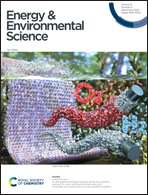Three-dimensional porous platinum–tellurium–rhodium surface/interface achieve remarkable practical fuel cell catalysis†
Abstract
Engineering high-efficiency surfaces/interfaces in electrocatalysts is critical for fuel cell commercialization. Herein, we construct a class of porous PtTeRh nanorods (NRs) with three-dimensional surfaces/interfaces for efficient oxygen reduction reaction (ORR) catalysts for practical fuel cells. The optimized porous Pt61Te8Rh31 NR/C exhibits 14-fold improvements in the ORR kinetics and remarkable self-breathing membrane electrode assembly (MEA) performance (a normalized power density of 1023.8 W g−1Pt, only 1.3% cell voltage loss after a 240 h durability test). Even under harsh operating fuel cell conditions, it can readily achieve a much higher power density (1976.1 mW cm−2) than commercial Pt/C (1338.8 mW cm−2). Simultaneously, it showed a 14.2% loss in peak power density after 30 000 cycles of the accelerated stress test (AST), while commercial Pt/C exhibited 25.7% peak power density loss under the same test conditions, demonstrating a highly active and durable cathodic catalyst for MEA. Density functional theory (DFT) calculations reveal the converse redox trend for Pt and Rh sites for optimizing the electron transfer during the ORR process. Te activates strong p–d couplings and preserves the robust electroactivity for superior electroactivity and durability. This work represents a significant advance in rationally designing multicomponent nanomaterials for practical fuel cell applications.



 Please wait while we load your content...
Please wait while we load your content...